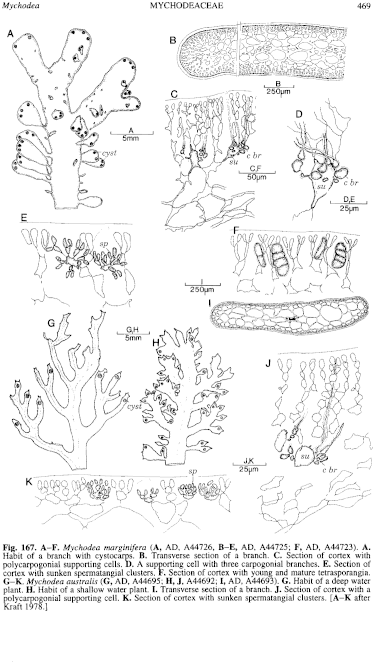|
|
|
|
|
|||||||||||
|
Electronic Flora of South Australia Species Fact Sheet
Phylum Rhodophyta – Class Florideophyceae – Order Gigartinales – Family Mychodeaceae
Synonyms
Neurophyllis australis Zanardini 1874: 499.
Ectoclinium dentatum J. Agardh 1876: 575; 1879: pl. 30 figs 1–8. Kylin 1932: 65; 1956: 306.
Ectoclinium latifrons J. Agardh 1885: 83. Kylin 1932: 65, pl. 28 fig. 69.
Mychodea halymenioides sensu J. Agardh 1885: 82. Kylin 1932: 65, pl. 27 fig. 68. [NON Zanardini 1874: 501].
Thallus (Fig. 166D) dark red-brown, (3–) 10–20 cm high, complanately branched with more or less subdichotomous, flat, main branches 2–7 mm broad, traversed by a fairly distinct central nerve (axial filament) (Fig. 167G, H), with numerous short, marginal, compressed, lateral branchlets of varying length, 0.5–1 (–2) mm broad, together with acuminate marginal spines, especially near branch apices. Holdfast crustose, 1–3 mm across; epiphytic or epilithic. Structure uniaxial, with a distinct apical cell and a prominent, relatively broad, axial filament (containing yellow material and forming the nerve) throughout (Fig. 166E), each cell producing two periaxial cells and cross-connector cells; inner medullary filaments slight around the axial filament (Fig. 167I), outer medulla of large cells without slender filaments, and the cortex of short anticlinal rows, outer cells ovoid, 2–4 iLim in diameter. Rhodoplasts discoid to elongate.
Reproduction: Sexual thalli monoecious; procarpic, polycarpogonial. Carpogonial branches (Fig. 167J) 3-celled, 2–4 borne on enlarged inner cortical cells near apices, auxiliary cells developing gonimoblast filaments thallus inwardly and laterally, producing clusters of ovoid carposporangia 10–15 µm in diameter within a filamentous matrix (Fig. 166F). Cystocarps (Fig. 167G, H) developing near apices of main and lateral branches, swollen, 350–500 mm across, with slight enveloping tissue and normal cortex which disintegrates for carpospore release. Spermatangial clusters (Fig. 167K) scattered on the faces of branches, sunken in the outer cortex, with 2–6 initials each producing 2 ovoid spermatangia 2–3 µm in diameter.
Tetrasporangia borne in slightly raised nemathecia on the surface of branches, laterally attached to mid-cortical cells, ovoid, 35–45 µm long and 20–25 µm in diameter, zonately divided.
Type from Port Phillip, Vic. (Mueller); holotype in Herb. Zanardini, Museo Civico di Storia Naturale, Venice.
Selected specimens: Albany, King George Sound, W. Aust., drift on tunicate stalk (Kraft, 11.xii.1971; AD, A44690). Vivonne Bay, Kangaroo I., S. Aust., 3–6 m deep on jetty piles (Kraft, 15.iv.1973; AD, A44692). Nora Creina, S. Aust., drift (Kraft 3767, 3.ix.1971; AD, A44693). Portsea, Vic., 3–5 m deep on jetty piles (Kraft & Saunders, 24.iii.1992; MELU, K8965). Cape Woolamai, Vic., 40–60 m deep (Watson, 2.iv.1972; AD, A44695). Crawfish Rock, Westernport Bay, Vic., 5–10 m deep (Watson & Owen, 29.viii.1971; AD, A46061). Gabo I., Vic., 23 m deep (Shepherd, 17.ii.1973; AD, A43487). Peggy Point, Bicheno, Tas., upper sublittoral pools (Wollaston & Mitchell, 2.iii.1964; AD, A27870). Fluted Cape, Bruny I., Tas., 10 m deep (Shepherd, 11.ii.1972; AD, A41802).
Distribution: King George Sound, W. Aust., to Gabo I., Vic., and around Tasmania.
Taxonomic notes: M. australis is one of the most distinctive species of Mychodea, characterised by the largely complanate branching, main branches 2–7 mm broad, usually with a distinct central nerve due to the broad axial filament, the cells of which contain a yellow substance, and the tetrasporangia arranged in slight nemathecia. It is not a common species but occurs on rocks, wood and also tunicates, from low tide level to 60 m deep.
References:
AGARDH, J.G. (1876). Species Genera et Ordines Algarum. Vol. 3, Part 1 - Epicrisis systematis Floridearum, pp. i-vii, 1–724. (Weigel: Leipzig.)
AGARDH, J.G. (1879). Florideernes morphologi. K. Svenska Vetensk. Akad. Handl. 15(6), 1–199, Plates 1–33.
AGARDH, J.G. (1885). Till algemes systematik. VII. Florideae. Acta Univ. lund. 21, 1–120, Plate 1.
KRAFT, G.T. (1978). Studies of marine algae in the lesser-known families of the Gigartinales (Rhodophyta). III. The Mychodeaceae and Mychodeophyllaceae. Aust. J. Bot. 26, 515–610.
KYLIN, H. (1932). Die Florideenordnung Gigartinales. Lunds Univ. Årsskr. N.F. Avd. 2, 28 (8), 1–88, Plates 1–28.
KYLIN, H. (1956). Die Gattungen der Rhodophyceen. (Gleerups: Lund.)
ZANARDINI, J. (1874). Phyceae Australicae novae vel minus cognitae. Flora (Regensburg) 57, 486–490, 497–505.
The Marine Benthic Flora of Southern Australia Part IIIA complete list of references.
Publication:
Womersley, H.B.S. (14 January, 1994)
The Marine Benthic Flora of Southern Australia
Rhodophyta. Part IIIA, Bangiophyceae and Florideophyceae (to Gigartinales)
Reproduced with permission from The Marine Benthic Flora of Southern Australia Part IIIA 1994, by H.B.S. Womersley. Australian Biological Resources Study, Canberra. Copyright Commonwealth of Australia.
Illustrations in Womersley Part IIIA, 1994: FIGS 166 D–F, 167 G–K.

Figure 166 enlarge
Fig. 166. A–C. Mychodea marginifera (A, AD, A21154; B, AD, A44725; C, AD, A44723). A. Habit of tetrasporangial plant. B. Habit of cystocarpic plant. C. Cross section of cystocarp, with cortical rupture on right. D–F. Mychodea australis (D, AD, A44692; E, F, AD, A41802). D. Habit. E. Longitudinal section with the darkly staining central filament and an enlarged auxiliary cell. F. Section of a mature cystocarp with the cortical rupture on the upper side. [B–F as in Kraft 1978.]

Figure 167 enlarge
Fig. 167. A–F. Mychodea marginifera (A, AD, A44726, B–E, AD, A44725; F, AD, A44723). A. Habit of a branch with cystocarps. B. Transverse section of a branch. C. Section of cortex with polycarpogonial supporting cells. D. A supporting cell with three carpogonial branches. E. Section of cortex with sunken spermatangial clusters. F. Section of cortex with young and mature tetrasporangia. G–K. Mychodea australis (G, AD, A44695; H, J, A44692; I, AD, A44693). G. Habit of a deep water plant. H. Habit of a shallow water plant. I. Transverse section of a branch. J. Section of cortex with a polycarpogonial supporting cell. K. Section of cortex with sunken spermatangial clusters. [A–K after Kraft 1978.]

|
Email Contact: State Herbarium of South Australia |

|